Which ethnic groups have the poorest health?
This report examines differences in the health of ethnic groups in Scotland and uses census health data to identify variations between groups. The analysis employs age-standardised rates to compare people of similar age, which avoids the often misleading direct comparisons between populations with very different age structures.
5. Analysis
5.1. Health Problem or Disability
Charts 5.1.1 and 5.1.2 show, for women and men separately, which ethnic groups have the best and worst health relative to the 'White: Scottish' reference group.
Chart 5.1.1: Ethnic Inequalities in Health for Women, 2011 - Age-standardised ratios of long-term limiting health problem or disability for ethnic groups compared to the 'White: Scottish' group
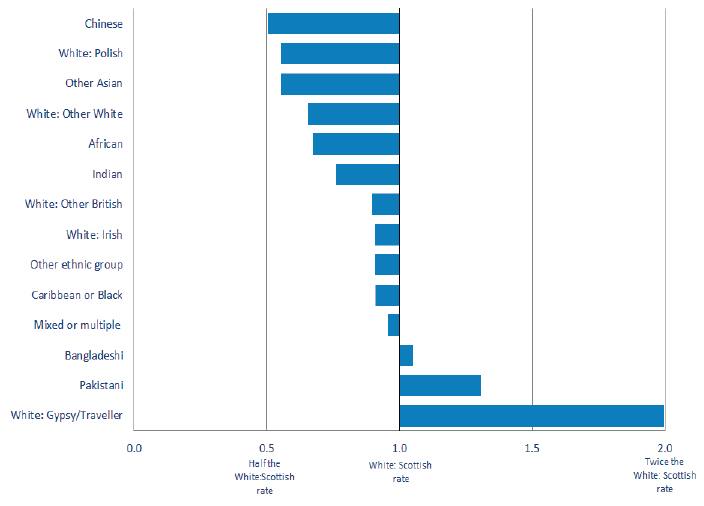
Chart 5.1.1 shows that in 2011 there was a wide variation in health problems or disability amongst women from different ethnic groups. Women from three groups - Bangladeshi, Pakistani and Gypsy/Traveller - recorded higher rates of 'health problem or disability' than women from the 'White: Scottish' ethnic group. Gypsy/Traveller women recorded twice the rate.
However, women from all the other ethnic groups recorded lower rates of 'health problem or disability' than those from the 'White: Scottish' ethnic group. 'Chinese', 'White: Polish' and 'Other Asian' women recorded almost half the rate.
The picture for women in Scotland was similar across ethnic groups to that of England and Wales. In England and Wales,[14] Chinese women also recorded the lowest rate of 'health problem or disability'[15], and this was less than half that of the 'White: British' group. Similar to the picture in Scotland, Gypsy/Traveller women recorded around twice the rate of the 'White: British' group. In England and Wales, as in Scotland, Pakistani and Bangladeshi women recorded higher rates than the 'White: British' group.[17]
Chart 5.1.2: Ethnic Inequalities in Health for Men, 2011 - Age-standardised ratios of long-term limiting health problem or disability for ethnic groups compared to the 'White: Scottish' group
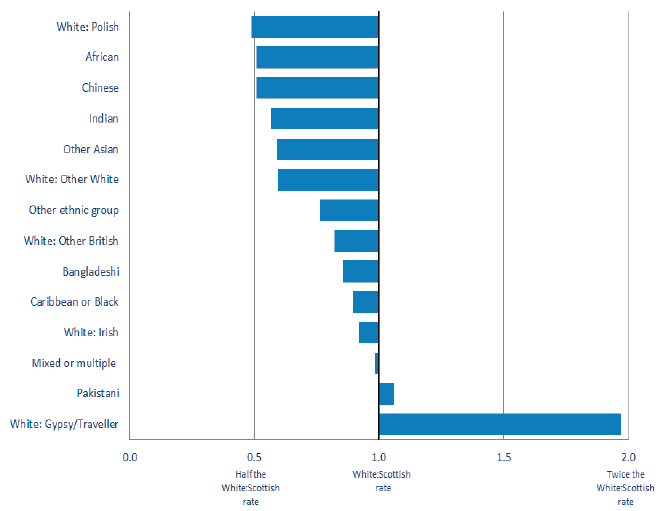
Chart 5.1.2 shows that, in 2011, men from only two ethnic groups - Pakistani and Gypsy/Traveller - recorded higher rates of 'health problem or disability' than men from the 'White: Scottish' ethnic group. Similar to the results for women, Gypsy/Traveller men recorded almost twice the rate.
As was the case for women, men from most ethnic groups recorded lower rates of 'health problem or disability' than those from the 'White: Scottish' ethnic group. 'White: Polish', 'African' and 'Chinese' men recorded the lowest prevalence at around half the rate.
The picture for men in Scotland was similar across ethnic groups to that of England and Wales. In England and Wales, Chinese men had the lowest rates of 'health problem or disability' and recorded a rate of less than half that of 'White: British' men. Similar to the results in Scotland, Gypsy/Traveller men in England and Wales also recorded almost twice the rate of the 'White: British' group.
Pakistani men in England and Wales recorded roughly the same as the 'White: British' rate whereas Pakistani men in Scotland recorded slightly higher rates than 'White: Scottish' men.
Charts 5.1.3 and 5.1.4 show how the rates of 'health problem or disability' increase with age and show how each ethnic group compares for five different age bands, again for women and men separately.
Chart 5.1.3: Long-term limiting health problem or disability for Women, by ethnic group and age band, 2011
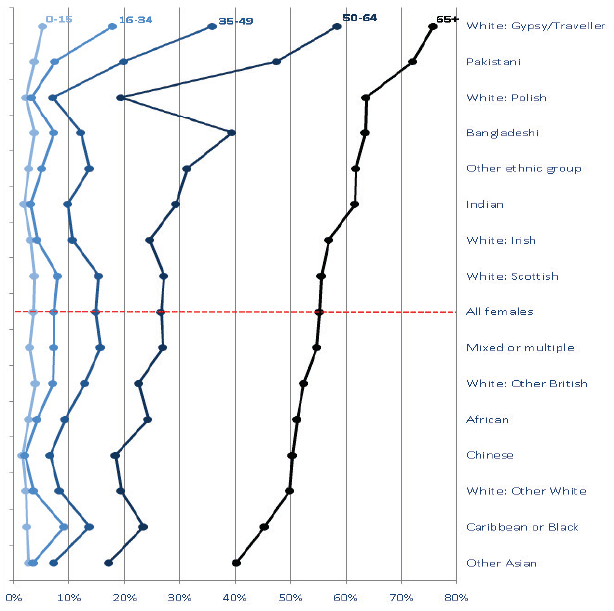
Chart 5.1.3 shows that health problems or disability for women are much more prevalent in older age bands - the majority (55 per cent) of women aged 65 or over reported a problem compared to only 7 per cent of women aged 16-34. Amongst those aged 65 or over, 'Other Asian' women reported the lowest rate (40 per cent) and Gypsy/Traveller women reported the highest (76 per cent).
The disadvantage for Gypsy/Traveller females starts early, with the youngest age groups showing higher rates than any other ethnic group. Those aged 16-34, 35-49 and 50-64 were more than twice as likely to have a 'health problem or disability' compared to all women in the population in these age bands.
'White: Polish' women aged under 65 reported relatively low prevalence of 'health problem or disability', whereas those aged 65 or over reported relatively high rates.
Like the results in England and Wales, older Pakistani and Bangladeshi women recorded high prevalence of health problems or disability, while Chinese women recorded low prevalence. In England and Wales, older Pakistani and Bangladeshi women actually recorded higher rates than older Gypsy/Traveller women.
Chart 5.1.4: Long-term limiting health problem or disability for Men, by ethnic group and age band, 2011
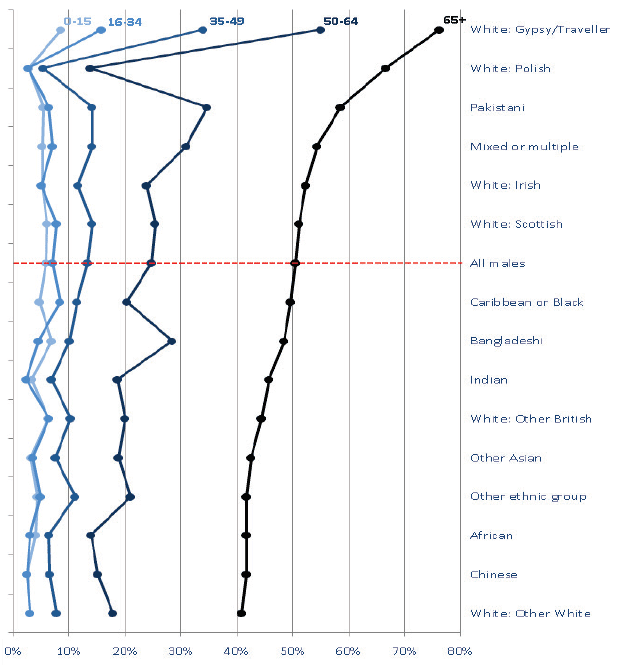
Chart 5.1.4 shows that half (50 per cent) of men aged 65 or over reported a 'health problem or disability'.
Older Gypsy/Traveller men in Scotland reported the highest rate (76 per cent) whereas older African, Chinese and 'White: Other White' men reported relatively low rates of around 40 per cent.
The disadvantage for Gypsy/Traveller males starts early, with the youngest age groups showing higher rates than any other ethnic group. Those aged 16-34, 35-49 and 50-64 were more than twice as likely to have a 'health problem or disability' compared to all men in the population in these age bands.
'White: Polish' men aged under 65 reported a relatively low prevalence of 'health problem or disability', whereas those aged 65 or over reported relatively high rates. Pakistani and Bangladeshi men aged 50-64 recorded relatively high rates.
Bangladeshi men in Scotland aged 65 or over recorded a lower prevalence than the 'White: Scottish' group, whereas Bangladeshi men in England and Wales recorded a much higher prevalence than the 'White: British' group.
As illustrated in the previous charts, older people have the highest rates of 'health problem or disability'. To draw out gender differences within ethnic groups the following chart, Chart 5.1.5 compares the rates for older women and men across the ethnic groups.
Chart 5.1.5: Long-term limiting health problem or disability, by ethnic group and gender for those aged 65+, 2011
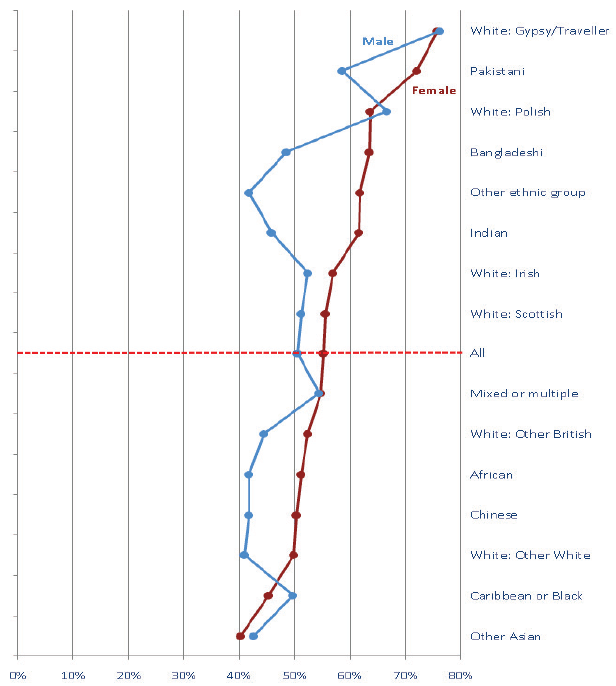
Chart 5.1.5 shows that women aged 65 or over reported higher rates of 'health problem or disability' than men across almost all of the ethnic groups, except for 'Caribbean or Black', 'White: Polish', 'Other Asian' and 'White: Gypsy/Traveller'.
The largest differences were for 'Indian', 'Bangladeshi' 'Pakistan' and 'Other Ethnic Group', where older women's health was much worse than older men's.
The following section presents age-standardised 'poor general health' data. Charts 5.2.1 and 5.2.2 show, for women and men separately, which ethnic groups had the poorest general health relative to the 'White: Scottish' reference group. This is analysis is based on the census question where respondents were asked to rate their 'health in general' whereas the previous analysis in section 5.1 covered the question on 'long-term limiting health problems or disability'.
Chart 5.2.1: Ethnic Inequalities in Health for Women, 2011 - Age-standardised ratios of General Health (Bad or Very Bad) for ethnic groups compared to the 'White: Scottish' group
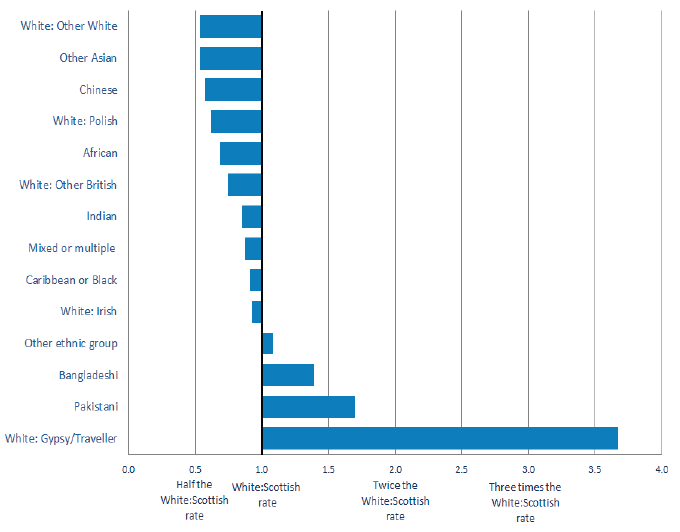
Chart 5.2.1 shows that the rate of 'poor general health' for women by ethnic group followed a similar order to the 'health problem or disability' data shown in Chart 5.1.1.
Gypsy/Traveller women were most likely to report that they had' poor general health' - this was over three and a half times the rate of the 'White: Scottish' ethnic group. Pakistani and Bangladeshi women were also more likely than the 'White: Scottish' group to report 'poor general health'. Along with 'Other ethnic group' these were the only groups who reported higher levels of 'poor general health' than the 'White: Scottish' ethnic group.
'White: Other White', 'Other Asian', 'Chinese' and 'White: Polish' women had low prevalence of 'health problem or disability' and also low prevalence of 'poor general health', at almost half the 'White Scottish' rate.
Chart 5.2.2: Ethnic Inequalities in Health for Men, 2011 - Age-standardised ratios of General Health (Bad or Very Bad) for ethnic groups compared to the 'White: Scottish' group
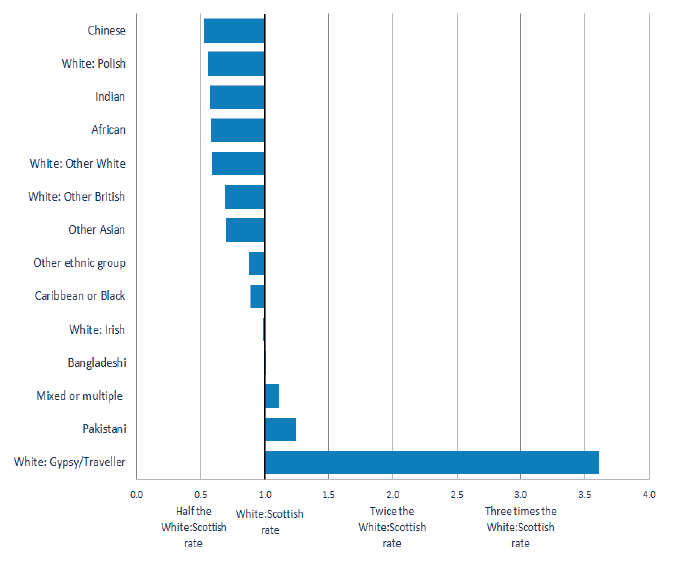
Chart 5.2.2 shows that the rate of Gypsy/Traveller men with 'poor general health' was over three and a half times that of the 'White: Scottish' ethnic group. This was similar to the result for Gypsy/Traveller women shown in Chart 5.2.1. Pakistani men and those with 'Mixed or multiple' ethnicity also had a higher rate of 'poor general health' than the 'White: Scottish' group.
Bangladeshi men had a similar rate of 'poor general health' to the 'White: Scottish' group, whereas Bangladeshi women had a higher rate.
'Chinese', 'White: Polish', 'Indian' and 'African' men recorded low rates of 'poor general health', almost half the 'White: Scottish' group.
Rates of 'poor general health' increase with age. The following charts, Charts 5.2.3 and 5.2.4, show these rates for each ethnic group across five different age bands. The information is presented separately for women and men.
Chart 5.2.3: General Health (Bad or Very Bad) of Women, by ethnic group and age band, 2011
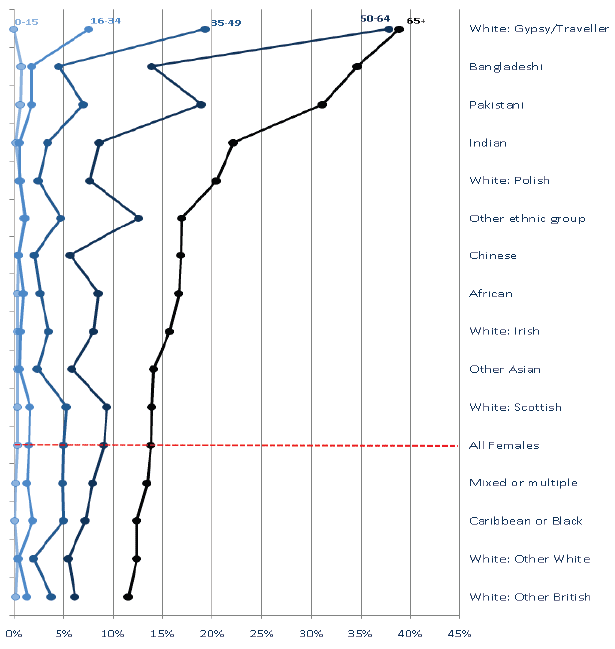
Chart 5.2.3 shows that the prevalence of 'poor general health' for women increases with age. Women aged 65 or over were most likely to report that they had 'poor general health' (14 per cent). However, this figure is much lower than those who reported a 'health problem or disability' (55 per cent).
Older Gypsy/Traveller women were almost three times more likely to report 'poor general health' compared to older women in the overall population. Gypsy/ Traveller women aged 50-64 were almost as likely to report bad or very bad health as those aged 65 or over.
Older Bangladeshi, Pakistani and Indian women reported relatively high rates of 'poor general health'. Whereas older 'White: Other British', 'White: Other White', 'Caribbean or Black' and 'Mixed or Multiple' women recorded lower than average rates.
Chart 5.2.4: General Health (Bad or Very Bad) of Men, by ethnic group and age band, 2011
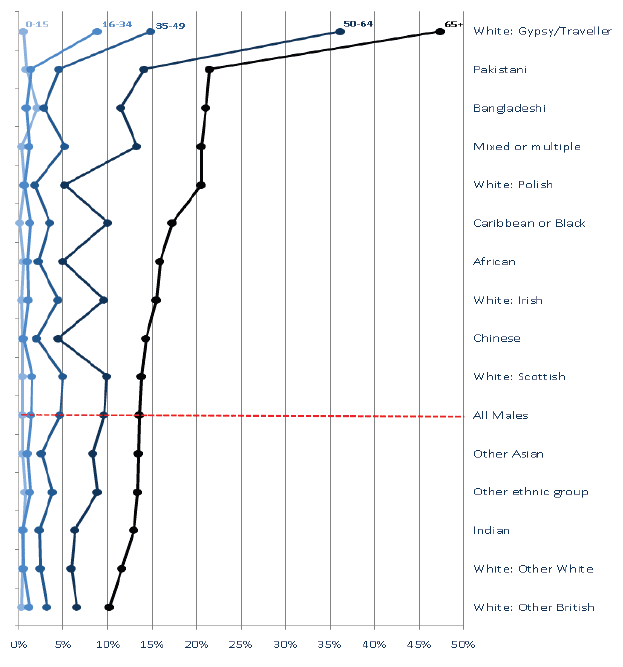
Chart 5.2.4 shows that Gypsy/Traveller men reported higher levels of 'poor general health' - almost half (47 per cent) of those aged 65 or over reported 'poor general health'. Around a fifth of older men with 'Pakistani', 'Bangladeshi' and 'Mixed or Multiple' ethnicity reported 'poor general health'.
Older Indian men reported low rates, as did older men with a 'White: Other British' ethnicity, where only one in ten reported 'poor general health'.
As illustrated in the previous charts, older people tend to have much higher rates of 'poor general health'. To draw out gender differences within ethnic groups the following chart, Chart 5.2.5, compares the rates for older women and men across the ethnic groups.
Chart 5.2.5: General Health (Bad or Very Bad), by gender, ethnic group for those aged 65+, 2011
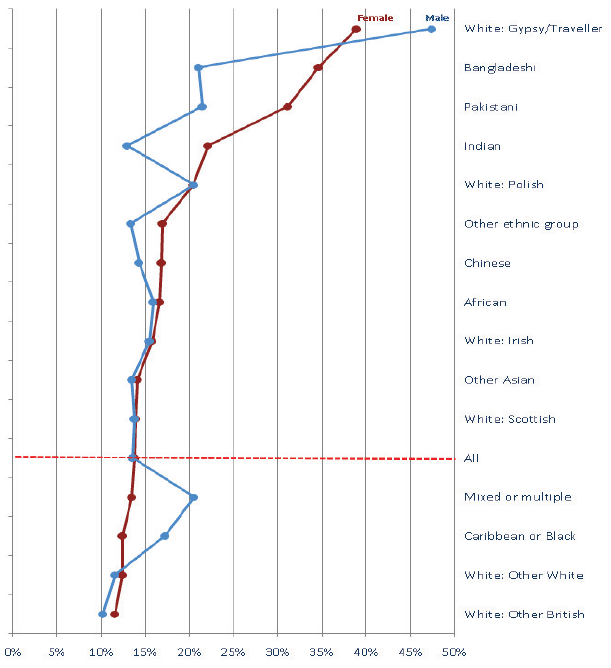
Chart 5.2.5 shows that the proportion of men aged 65 or over who reported 'poor general health' was the same as the proportion of women (14 per cent).
The chart highlights that Bangladeshi, Pakistani and Indian women aged 65 or over reported high rates of 'poor general health' compared to the rates for men in those groups.
The ethnic groups where older men reported higher rates of 'poor general health' than older women were 'White: Gypsy/Traveller', 'Mixed or Multiple' and 'Caribbean or Black'.
Contact
Email: Jon Hunter
There is a problem
Thanks for your feedback